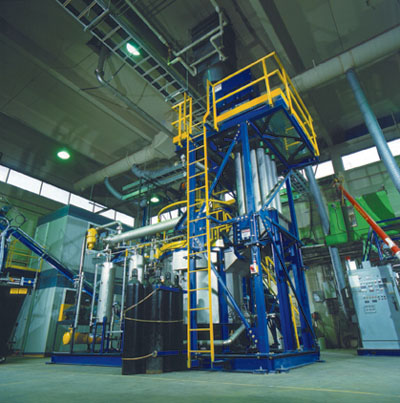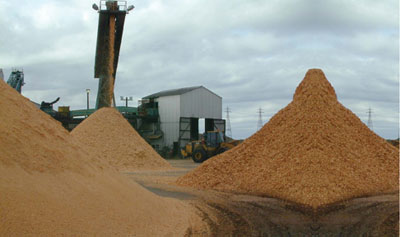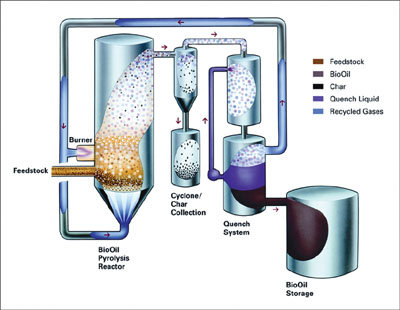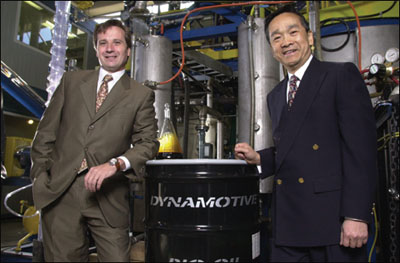If you’ve been following the development of renewable energy for any length of time, you’ve seen the push and pull between the true believers and the begrudging compliers. But if the momentum around a new technology called fast pyrolysis continues, there may soon be a meeting of the minds.
Put simply, fast pyrolysis is a process for converting biomass collected from agricultural and forest residues into an organic liquid fuel, called BioOil, that’s easily transported, stored and handled. The beauty is that, while the BioOil itself can be used to generate carbon-neutral, cost-effective process heat and electricity, the means for producing it can also dispose of organic waste and even create new jobs and industries.
“For the first time, BioOil makes biomass fully transportable,” said Patricia Seifert, a research analyst from Frost & Sullivan, a leading global consulting firm. “Plus, there are subproducts from BioOil that go beyond just producing electricity."
Just what is BioOil? And, if it does offer obvious economic, environmental and energy benefits, why isn’t every electric company getting into the act? The fact is that they may soon be doing so. Consider just two recent developments:
In September 2003, the U.S. Department of Energy (DOE) announced it had teamed with the U.S. Department of Agriculture to award $23 million in biomass research funding to 19 projects across the U.S. In announcing the funding, U.S. Agriculture Secretary Ann M. Veneman said, "The conversion of biomass into bio-based products, fuel and energy offers significant benefits to the nation through healthier rural economies, improved environmental quality and improved energy dependence."
A month earlier, the Government of Canada announced details of its $1 billion investment toward implementation of the Climate Change Program for Canada. Among its highlights: A commitment of $30 million to support the development and demonstration of bio-based energy systems and technologies.
These national initiatives are just a fraction of what’s being done to boost biomass from an alsoran to a front-runner in the North American energy market. States, provinces and even municipalities are looking to partner with energy companies, forestry and agriculture interests, local manufacturers, and other key customers on biomass projects that can supply energy needs, jump-start their economies, and actively address public concerns on climate change and pollution.
Why Biomass? Why Now? What’s New?
One could say that society has been refining biopower since man first rubbed two sticks together. By 1850, fuelwood represented about 91 percent of the total energy supply of the United States. But today’s biopower is far afield from the dirty, smoke-spewing, relatively low-efficiency combustion stacks of just a few years ago. With the recent advent of pyrolysis, gasification, plasma gasification and anaerobic digestion technologies, biopower is now being hailed as a clean, commercially viable solution to many of North America’s energy, economic and environmental challenges. One reason: It’s a CO2 neutral, cyclical process. When biomass is converted into thermal energy, the carbon dioxide that’s released is roughly equivalent to the carbon dioxide that went into growing the biomass.
Even before the major national grants awarded to biomass projects in the U.S. and Canada, industry analysts were predicting an industry boost. For example, in a June 2003 report, Frost & Sullivan reported that financial incentives from government sources were likely to propel the North American BioMass and Wasteto- Energy Markets from market generated revenues worth $350 million in 2003 to revenues worth as much as $1 billion in 2012.
“New technologies are likely to call the shots as they generate clean gas that can be used with highly efficient production systems such as gas turbines, fuel cells and micro-turbines,” said Seifert. “Along with this, the generation of many by-products such as bio-fertilizers, bio-oil, new tile and road materials are expected to produce additional revenues.”
Likewise, some far-sighted energy companies, like Ontario Power Generation (OPG), owned by the Ontario Government, were quick to give new biomass technologies a serious look.
“Utilities are looking for ways to manage emissions, supply green power requirements, and meet potential renewable energy portfolio standards. At the same time, the technology is starting to become available to allow biomass to be used more easily,” said James Perry, senior Business Development engineer at OPG.
That’s one reason that OPG decided this year to invest in a fast pyrolysis technology that allows raw biomass, which typically has a very low energy content, to be converted into a fuel that can be transported away from the biomass source. The other benefit, said Perry, is that it’s easier to use converted BioOil in existing generating facilities than it would be to use raw biomass.
He explained, “You can use BioOil in coal, oil or natural gas-fired boilers with far fewer modifications than would be needed for raw wood or agricultural waste. Assuming that it is proven on a large commercial scale, BioOil should allow utilities to access biomass more easily than ever.”
The Proof is in the Power
For many energy companies, interest in developing biomass has been steadily growing in recent years, especially in reaction to the Kyoto Protocol, the proposed U.S. energy policy, and renewable portfolios in dozens of U.S. states. The key is determining the best way to move forward.
For OPG, a major break came when they were introduced to another Canadian company, DynaMotive Energy Systems Corporation. DynaMotive, the world leader in fast pyrolysis technology, is in the business of developing and commercializing environmentally friendly energy systems based on fuels produced from biomass. When DynaMotive invited OPG to become the first market-leading generation company to participate in developing a large-scale commercial BioOil plant, OPG seized on the opportunity.
The project involves building a 100 tonne per day BioOil plant at the site of Erie Flooring and Wood Products, in West Lorne, Ontario, using DynaMotive’s patented fast pyrolysis process, called BioThermTM. The project is actually the expansion and commercialization of DynaMotive’s 10 tonne per day pilot project in which the company successfully used the BioThermTM process to produce BioOil.
“It’s instrumental to have a leading generation company, like OPG, recognize the commercial potential of this technology and how important it is to the collective future for renewable energy and our environment,” said Andrew Kingston, President & CEO of DynaMotive.
Erie Flooring and Wood Products will supply wood residue for the project, which will use fast pyrolysis to convert the residue to BioOil. That process should generate enough electricity and process heat to not only power Erie’s operations, but to also export excess power to the Ontario grid. Magellan Aerospace Corporation, Orenda division will provide the project’s 2.5-megawatt OGT2500 gas turbine that will combust the bio-oil and generate electricity. Ramsey Machine Works, Ltd., meanwhile, will work with DynaMotive and UMA Engineering to fabricate the pyrolysis plant, capable of processing 100- tonnes of biomass feedstock per day.
Perry noted that OPG already gets a very small portion of green power from biomass, but the BioThermTM BioOil project marks its first direct investment in the renewable technology. Currently, the biopower included in OPG’s green power offering, marketed under OPG - EvergreenTM Energy, comes from power purchase agreements.
“We’re carefully and conservatively looking at this new BioOil plant as an additional option,” said Perry. “At this point, the goal is to prove the pyrolysis technology in a commercial environment.”
All of the project participants are looking well beyond the current project. For example, Ramsey Machine Works, Ltd. and UMA Engineering are collaboratively developing an adaptive process that will allow companies interested in similar projects to build on the existing 100-tonne per day module plant, using up to three additional 100-tonne modules for a total 400-tonne per day plant.
“We expect the project to meet the energy demands of Erie Flooring and Wood Products, plus it has capability to begin contributing about 1.5 megawatts of power to OPG’s green energy portfolio in 2004,” said Kingston. "We’re confident that after seeing a commercial project of this scale, more energy companies will begin investing in BioOil facilities."
A Technology for Our Times
“This is an incredibly flexible, clean and cost effective technology for electric energy companies and their customers,” said Kingston. “Some companies may choose to build BioOil plants because of the need for distributed generation, some may need the renewable energy to meet state portfolio standards, some may want to sell emission credits to other companies burning dirtier fuel, and still others may use the BioOil to replace fossil fuels in their own plants. With our model, they can build and market to suit their needs.”
He continued, “Traditional hydrocarbon oil would need to sell for less than $15 per barrel to be competitive with BioOil. Oil prices that low are just not realistic in today’s day and age, so BioOil really does have a ready advantage.”
Another factor in the equation is transporting fuel sources to where energy is produced. When produced from locally harvested biomass in markets that can use the BioOil right away, BioOil easily competes with the full life cycle costs of hydrocarbon oil. Add to that ancillary benefits – like the sale of value-added char or trading pollution credits – and the process really begins to pay off for electric companies and their customers.
Thus far, DynaMotive has successfully produced BioOil with about 70 different feedstocks, making it practical to produce virtually anywhere and as easily transportable as diesel oil. Although the finished product has higher specific gravity than diesel oil, it has lower viscosity and flows more freely.
Mark Wilhelm, president of GreenBuilt Consulting and a long-time electric energy marketing and research leader, described BioOil as “environmentally sound, convenient, practical, innovative, efficient and economical.” On top of all that, he said it supports the role of electric companies as community leaders, especially when it comes to environmental, economic, and quality of life initiatives and indicators.
“BioOil is a technology with legs,” said Wilhelm. “It addresses many of the current issues that directly affect electric energy companies, and it provides opportunities to partner with key accounts, government agencies, environmental organizations, economic development, and even agricultural and forestry interests. There’s also a potential for BioOil to someday be used in several utility-specific applications, such as environmentally-friendly treatment of wooden poles.”
BioTherm™ is DynaMotive’s patented fast pyrolysis process that takes organic residues, such as forest and agricultural wastes, and quickly – in less than two seconds – converts them into BioOil, char and non-condensable gases. (See accompanying progress diagram).
Think of preparing a meal with a high temperature pressure cooker. First, one might break-up the ingredients to remove excess moisture and ensure all ingredients get cooked. For BioTherm™, this includes drying the feedstock to less than 10 percent moisture content and grinding the feed into small particles. This minimizes water content in the resulting BioOil, and ensures rapid reaction during the ensuing pyrolysis process.
The dried biomass is then fed into a completely sealed system (a bubbling fluid-bed reactor) that operates at normal atmospheric pressure, but at a temperature of about 500 degrees Celsius. Absent oxygen, the high temperatures cause a physical reaction, which changes the dried biomass residues into a vapor or gas. In order to capture the gas and convert it to a useable form, the system rapidly drops in temperature and quenches the heated biomass. This temperature drop also prevents the cracking of the newly produced BioOil.
A key advantage of this process is that the solid residues or char left behind are used for other clean chemical applications, while the noncondensable gases are fed back into the system to create additional process heat. Everything else is converted to BioOil.
The process is particularly appealing to energy companies and their private sector customers (as well as government partners) in areas with large forestry or agricultural potential. For example, in mid-2002, New Hampshire began a BioOil feasibility study in which DynaMotive participated, funded by grants from the U.S. Department of Energy and the U.S. Department of Agriculture. The state is now looking at using BioOil to help revitalize its wood products’ industry, fuel combustion turbines, and provide feedstocks for “green” chemical industries.
“We’re currently looking at colocating a BioOil facility near an existing biomass power plant,” said James Taylor, director of Grants and Program Development for the New Hampshire Office of Energy and Planning. He explained that the state would both purchase power from the biomass facility and use its wood chipper equipment.
“There are some tremendous synergies,” said Taylor. “We’d use the biomass power to start the BioOil process, and then the BioOil process would, in essence, self-generate. We’d then extract the desirable green chemicals and use the remaining residue as a fuel that goes back into the biomass plant.”
According to virtually everyone involved, there are natural synergies – both in the process to produce BioOil and in the community and customer relationships formed when implementing a BioOil project. Better still, the process makes economic and environmental sense, even to non-technical audiences. Participants in the energy industry can score “quick hits” with customers and community leaders by clearly demonstrating their commitment to clean energy, lower costs and improved efficiencies. At the same time, they’re meeting their own shortand long-term business needs.
The process also appears to be gaining favor as a way for thinning forests, especially in light of recent fires in the Western United States and resultant public and media attention given to forest management.
DynaMotive’s Chief Forester Dr. Luc C. Duchesne, who is on loan from the Canadian Forestry Service’s Great Lakes Forestry Center (GLFC) in Sault Ste Marie, Ont., is currently working to help develop additional commercial BioOil opportunities.
He added, “We have the technology to export that energy, and that’s especially important now because we are reaching what’s called Hubbert’s Peak. That means that, more and more, energy is becoming a critical issue. In fact, it’s the most critical issue controlling economic growth.”
According to University of Saskatchewan Chemical Engineering Professor A.K. Delai, another Canadian researcher working extensively with BioOil and DynaMotive, biomass already supplies about 15 percent of the world’s energy, and has long been identified as the world’s largest sustainable source of renewable energy. On average, he says, one-third of the total energy supply of Third World countries comes from biomass, whereas the contribution in industrialized nations is about 3 percent.
Resources needed to produce BioOil are globally abundant, easily accessible, renewable, and greenhouse gas neutral. Plus, by converting biomass to BioOil, companies overcome what have traditionally been drawbacks to using biomass. Its compatible with fuel infrastructure, can be used with easily modified gas turbines and reciprocating engines, and increases energy density by seven-to-one over traditional biomass.
Put simply, fast pyrolysis is a process for converting biomass collected from agricultural and forest residues into an organic liquid fuel, called BioOil, that’s easily transported, stored and handled. The beauty is that, while the BioOil itself can be used to generate carbon-neutral, cost-effective process heat and electricity, the means for producing it can also dispose of organic waste and even create new jobs and industries.
“For the first time, BioOil makes biomass fully transportable,” said Patricia Seifert, a research analyst from Frost & Sullivan, a leading global consulting firm. “Plus, there are subproducts from BioOil that go beyond just producing electricity."
Just what is BioOil? And, if it does offer obvious economic, environmental and energy benefits, why isn’t every electric company getting into the act? The fact is that they may soon be doing so. Consider just two recent developments:
In September 2003, the U.S. Department of Energy (DOE) announced it had teamed with the U.S. Department of Agriculture to award $23 million in biomass research funding to 19 projects across the U.S. In announcing the funding, U.S. Agriculture Secretary Ann M. Veneman said, "The conversion of biomass into bio-based products, fuel and energy offers significant benefits to the nation through healthier rural economies, improved environmental quality and improved energy dependence."
A month earlier, the Government of Canada announced details of its $1 billion investment toward implementation of the Climate Change Program for Canada. Among its highlights: A commitment of $30 million to support the development and demonstration of bio-based energy systems and technologies.
These national initiatives are just a fraction of what’s being done to boost biomass from an alsoran to a front-runner in the North American energy market. States, provinces and even municipalities are looking to partner with energy companies, forestry and agriculture interests, local manufacturers, and other key customers on biomass projects that can supply energy needs, jump-start their economies, and actively address public concerns on climate change and pollution.
Why Biomass? Why Now? What’s New?
One could say that society has been refining biopower since man first rubbed two sticks together. By 1850, fuelwood represented about 91 percent of the total energy supply of the United States. But today’s biopower is far afield from the dirty, smoke-spewing, relatively low-efficiency combustion stacks of just a few years ago. With the recent advent of pyrolysis, gasification, plasma gasification and anaerobic digestion technologies, biopower is now being hailed as a clean, commercially viable solution to many of North America’s energy, economic and environmental challenges. One reason: It’s a CO2 neutral, cyclical process. When biomass is converted into thermal energy, the carbon dioxide that’s released is roughly equivalent to the carbon dioxide that went into growing the biomass.
Even before the major national grants awarded to biomass projects in the U.S. and Canada, industry analysts were predicting an industry boost. For example, in a June 2003 report, Frost & Sullivan reported that financial incentives from government sources were likely to propel the North American BioMass and Wasteto- Energy Markets from market generated revenues worth $350 million in 2003 to revenues worth as much as $1 billion in 2012.
“New technologies are likely to call the shots as they generate clean gas that can be used with highly efficient production systems such as gas turbines, fuel cells and micro-turbines,” said Seifert. “Along with this, the generation of many by-products such as bio-fertilizers, bio-oil, new tile and road materials are expected to produce additional revenues.”
Likewise, some far-sighted energy companies, like Ontario Power Generation (OPG), owned by the Ontario Government, were quick to give new biomass technologies a serious look.
“Utilities are looking for ways to manage emissions, supply green power requirements, and meet potential renewable energy portfolio standards. At the same time, the technology is starting to become available to allow biomass to be used more easily,” said James Perry, senior Business Development engineer at OPG.
That’s one reason that OPG decided this year to invest in a fast pyrolysis technology that allows raw biomass, which typically has a very low energy content, to be converted into a fuel that can be transported away from the biomass source. The other benefit, said Perry, is that it’s easier to use converted BioOil in existing generating facilities than it would be to use raw biomass.
He explained, “You can use BioOil in coal, oil or natural gas-fired boilers with far fewer modifications than would be needed for raw wood or agricultural waste. Assuming that it is proven on a large commercial scale, BioOil should allow utilities to access biomass more easily than ever.”
The Proof is in the Power
For many energy companies, interest in developing biomass has been steadily growing in recent years, especially in reaction to the Kyoto Protocol, the proposed U.S. energy policy, and renewable portfolios in dozens of U.S. states. The key is determining the best way to move forward.

For OPG, a major break came when they were introduced to another Canadian company, DynaMotive Energy Systems Corporation. DynaMotive, the world leader in fast pyrolysis technology, is in the business of developing and commercializing environmentally friendly energy systems based on fuels produced from biomass. When DynaMotive invited OPG to become the first market-leading generation company to participate in developing a large-scale commercial BioOil plant, OPG seized on the opportunity.
The project involves building a 100 tonne per day BioOil plant at the site of Erie Flooring and Wood Products, in West Lorne, Ontario, using DynaMotive’s patented fast pyrolysis process, called BioThermTM. The project is actually the expansion and commercialization of DynaMotive’s 10 tonne per day pilot project in which the company successfully used the BioThermTM process to produce BioOil.
“It’s instrumental to have a leading generation company, like OPG, recognize the commercial potential of this technology and how important it is to the collective future for renewable energy and our environment,” said Andrew Kingston, President & CEO of DynaMotive.
Erie Flooring and Wood Products will supply wood residue for the project, which will use fast pyrolysis to convert the residue to BioOil. That process should generate enough electricity and process heat to not only power Erie’s operations, but to also export excess power to the Ontario grid. Magellan Aerospace Corporation, Orenda division will provide the project’s 2.5-megawatt OGT2500 gas turbine that will combust the bio-oil and generate electricity. Ramsey Machine Works, Ltd., meanwhile, will work with DynaMotive and UMA Engineering to fabricate the pyrolysis plant, capable of processing 100- tonnes of biomass feedstock per day.

Perry noted that OPG already gets a very small portion of green power from biomass, but the BioThermTM BioOil project marks its first direct investment in the renewable technology. Currently, the biopower included in OPG’s green power offering, marketed under OPG - EvergreenTM Energy, comes from power purchase agreements.
“We’re carefully and conservatively looking at this new BioOil plant as an additional option,” said Perry. “At this point, the goal is to prove the pyrolysis technology in a commercial environment.”
All of the project participants are looking well beyond the current project. For example, Ramsey Machine Works, Ltd. and UMA Engineering are collaboratively developing an adaptive process that will allow companies interested in similar projects to build on the existing 100-tonne per day module plant, using up to three additional 100-tonne modules for a total 400-tonne per day plant.
“We expect the project to meet the energy demands of Erie Flooring and Wood Products, plus it has capability to begin contributing about 1.5 megawatts of power to OPG’s green energy portfolio in 2004,” said Kingston. "We’re confident that after seeing a commercial project of this scale, more energy companies will begin investing in BioOil facilities."
A Technology for Our Times
“This is an incredibly flexible, clean and cost effective technology for electric energy companies and their customers,” said Kingston. “Some companies may choose to build BioOil plants because of the need for distributed generation, some may need the renewable energy to meet state portfolio standards, some may want to sell emission credits to other companies burning dirtier fuel, and still others may use the BioOil to replace fossil fuels in their own plants. With our model, they can build and market to suit their needs.”
He continued, “Traditional hydrocarbon oil would need to sell for less than $15 per barrel to be competitive with BioOil. Oil prices that low are just not realistic in today’s day and age, so BioOil really does have a ready advantage.”
Another factor in the equation is transporting fuel sources to where energy is produced. When produced from locally harvested biomass in markets that can use the BioOil right away, BioOil easily competes with the full life cycle costs of hydrocarbon oil. Add to that ancillary benefits – like the sale of value-added char or trading pollution credits – and the process really begins to pay off for electric companies and their customers.
Thus far, DynaMotive has successfully produced BioOil with about 70 different feedstocks, making it practical to produce virtually anywhere and as easily transportable as diesel oil. Although the finished product has higher specific gravity than diesel oil, it has lower viscosity and flows more freely.
Mark Wilhelm, president of GreenBuilt Consulting and a long-time electric energy marketing and research leader, described BioOil as “environmentally sound, convenient, practical, innovative, efficient and economical.” On top of all that, he said it supports the role of electric companies as community leaders, especially when it comes to environmental, economic, and quality of life initiatives and indicators.
“BioOil is a technology with legs,” said Wilhelm. “It addresses many of the current issues that directly affect electric energy companies, and it provides opportunities to partner with key accounts, government agencies, environmental organizations, economic development, and even agricultural and forestry interests. There’s also a potential for BioOil to someday be used in several utility-specific applications, such as environmentally-friendly treatment of wooden poles.”
Fast-Pyrolysis: How, Why and Where it Works
BioTherm™ is DynaMotive’s patented fast pyrolysis process that takes organic residues, such as forest and agricultural wastes, and quickly – in less than two seconds – converts them into BioOil, char and non-condensable gases. (See accompanying progress diagram).

Think of preparing a meal with a high temperature pressure cooker. First, one might break-up the ingredients to remove excess moisture and ensure all ingredients get cooked. For BioTherm™, this includes drying the feedstock to less than 10 percent moisture content and grinding the feed into small particles. This minimizes water content in the resulting BioOil, and ensures rapid reaction during the ensuing pyrolysis process.
The dried biomass is then fed into a completely sealed system (a bubbling fluid-bed reactor) that operates at normal atmospheric pressure, but at a temperature of about 500 degrees Celsius. Absent oxygen, the high temperatures cause a physical reaction, which changes the dried biomass residues into a vapor or gas. In order to capture the gas and convert it to a useable form, the system rapidly drops in temperature and quenches the heated biomass. This temperature drop also prevents the cracking of the newly produced BioOil.
A key advantage of this process is that the solid residues or char left behind are used for other clean chemical applications, while the noncondensable gases are fed back into the system to create additional process heat. Everything else is converted to BioOil.
The process is particularly appealing to energy companies and their private sector customers (as well as government partners) in areas with large forestry or agricultural potential. For example, in mid-2002, New Hampshire began a BioOil feasibility study in which DynaMotive participated, funded by grants from the U.S. Department of Energy and the U.S. Department of Agriculture. The state is now looking at using BioOil to help revitalize its wood products’ industry, fuel combustion turbines, and provide feedstocks for “green” chemical industries.
“We’re currently looking at colocating a BioOil facility near an existing biomass power plant,” said James Taylor, director of Grants and Program Development for the New Hampshire Office of Energy and Planning. He explained that the state would both purchase power from the biomass facility and use its wood chipper equipment.
“There are some tremendous synergies,” said Taylor. “We’d use the biomass power to start the BioOil process, and then the BioOil process would, in essence, self-generate. We’d then extract the desirable green chemicals and use the remaining residue as a fuel that goes back into the biomass plant.”
According to virtually everyone involved, there are natural synergies – both in the process to produce BioOil and in the community and customer relationships formed when implementing a BioOil project. Better still, the process makes economic and environmental sense, even to non-technical audiences. Participants in the energy industry can score “quick hits” with customers and community leaders by clearly demonstrating their commitment to clean energy, lower costs and improved efficiencies. At the same time, they’re meeting their own shortand long-term business needs.

The process also appears to be gaining favor as a way for thinning forests, especially in light of recent fires in the Western United States and resultant public and media attention given to forest management.
DynaMotive’s Chief Forester Dr. Luc C. Duchesne, who is on loan from the Canadian Forestry Service’s Great Lakes Forestry Center (GLFC) in Sault Ste Marie, Ont., is currently working to help develop additional commercial BioOil opportunities.
He added, “We have the technology to export that energy, and that’s especially important now because we are reaching what’s called Hubbert’s Peak. That means that, more and more, energy is becoming a critical issue. In fact, it’s the most critical issue controlling economic growth.”
According to University of Saskatchewan Chemical Engineering Professor A.K. Delai, another Canadian researcher working extensively with BioOil and DynaMotive, biomass already supplies about 15 percent of the world’s energy, and has long been identified as the world’s largest sustainable source of renewable energy. On average, he says, one-third of the total energy supply of Third World countries comes from biomass, whereas the contribution in industrialized nations is about 3 percent.
Resources needed to produce BioOil are globally abundant, easily accessible, renewable, and greenhouse gas neutral. Plus, by converting biomass to BioOil, companies overcome what have traditionally been drawbacks to using biomass. Its compatible with fuel infrastructure, can be used with easily modified gas turbines and reciprocating engines, and increases energy density by seven-to-one over traditional biomass.








